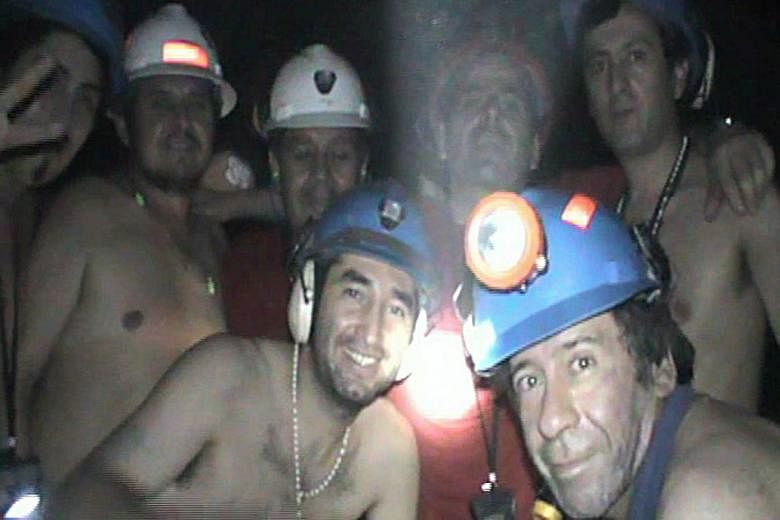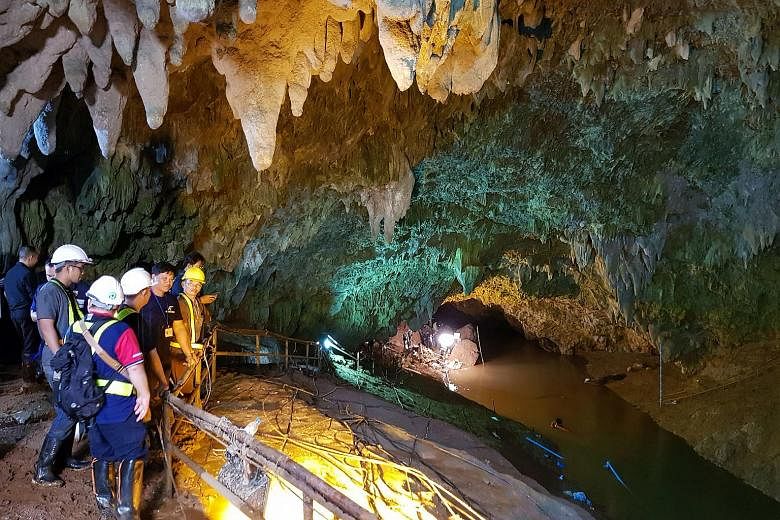An Indonesian teenager survived for 49 days adrift in Guam waters before he was rescued by a Panama-flagged vessel on Aug 31.
Aldi Novel Adilang, 19, was a lamp keeper for a floating fish trap 125km out at sea, where he had brief human contact weekly and only a walkie-talkie.
On July 14, after keeping the trap for months, a hard wind blew him thousands of kilometres away from home in North Sulawesi to Guam waters.
For 49 days, more than 10 ships had sailed past Mr Aldi but failed to spot him as he waved for help.
He caught fish to stave off hunger and drank sea water, and when he ran out of cooking gas, burned the rompong's wooden fences to make a fire for cooking.
Here are other dramatic rescue operations that ended happily despite massive obstacles.
Tham Luang, Thailand. 2018
For days, Thailand anxiously followed every twist and turn of a dramatic race against time to find twelve boys and their football coach trapped deep in a cave complex and surrounded by rising monsoon floodwaters.
The boys, aged between 11 and 16, and their 25-year-old coach disappeared on June 23 during an outing to the Tham Luang cave complex, which runs for 10km beneath the mountains in northern Chiang Rai province.
Aside from belongings left at the mouth of the cave and handprints on the walls, nothing else had been found until late on July 2.
Rescue divers took three days to pull the boys out of the cave one by one, starting July 7.
Gramat, France. 1999
On Nov 22, 1999, rescuers reached seven men who had been trapped in a cave system in south-west France for 10 days.
The men, all experienced cavers, became trapped in the caves at Vitarelles when heavy storms caused flooding, cutting them off from the exits.
The unprecedented rescue mission riveted France, with experts drilling multiple shafts into the rock in a bid to find the men.
They eventually reached them after squeezing into one of the shafts and following an underground river.
The men had carefully rationed their food and still had enough water and lighting gas for two days when they were rescued. All were in good health.
Kamchatka Peninsula, Russia. 2005
The seven-man crew of a Russian Priz mini-submarine were running out of air after three days trapped under water when they were finally rescued.
Their submarine became entangled in marine debris on Aug 4, 2005, and the Russian crew was powerless to move from the position around 190m below the ocean surface.
The incident immediately drew comparisons with Russia's Kursk submarine accident five years earlier, which ended in tragedy with the deaths of all 118 crew.
But the Priz crew were rescued after a British undersea robot cut the vessel free.
Russian President Vladimir Putin awarded medals to the British team who rescued the submarine crew and Moscow announced it would purchase several of the type of underwater robots used in the rescue.
Copiapo, Chile. 2010
The plight of 33 men trapped in a Chilean mine 600m underground after a rock collapse on Aug 5, 2010 captured international headlines.
The men had been virtually given up for dead when a probe sent down through a narrow borehole struck lucky, 17 days later.
The men had been surviving on dwindling rations, with just 15 cans of tuna between them, said survivor Franklin Lobos.
"We ate a teaspoon of it every 24 hours, then every 48 hours and finally we were eating a teaspoon every 72 hours. It was horrible."
Even after the men were located and supplies were sent to them, it took weeks before rescuers were finally able to bring the miners to the surface.
In all, their ordeal lasted nearly 70 days.
Ica, Peru. 2012
Nine miners, including a father and son, spent seven days trapped underground after a cave-in in southern Peru on April 7, 2012.
Rescuers led the men out wrapped in blankets and wearing dark glasses to protect their eyes after so many days without sunlight.
The rescue operation at the illegal mine was hampered by fears of additional collapses as rescuers dug through rock and soil.
Huddled in an opening 250m underground, the men joked and exercised to pass the time and stay positive.
"This moment, it's like being reborn," said one of the rescued men after a tearful reunion with his family.
Untersberg, Germany. 2014
More than 700 emergency personnel worked to rescue Johann Westhauser after he sustained a serious head injury deep inside a German cave system on June 8, 2014.
The 52-year-old was with two other people when a rockfall caused the head injury. One made the hours-long walk back to the surface to raise the alarm, while the other stayed with Westhauser.
His injury made it impossible for him to move, and rescue workers and medical professionals from five countries worked to medically evacuate him from a spot 1,000m below ground.
His rescuers battled dangerous conditions and near-freezing temperatures as they methodically negotiated a treacherous network of tunnels and chambers, underground lakes and ice-cold waterfalls.
He was eventually hauled out of the cave system on a stretcher 11 days after being injured, in an operation local officials said had seemed "simply impossible."
SOURCES: AFP, THE JAKARTA POST/ASIA NEWS NETWORK



